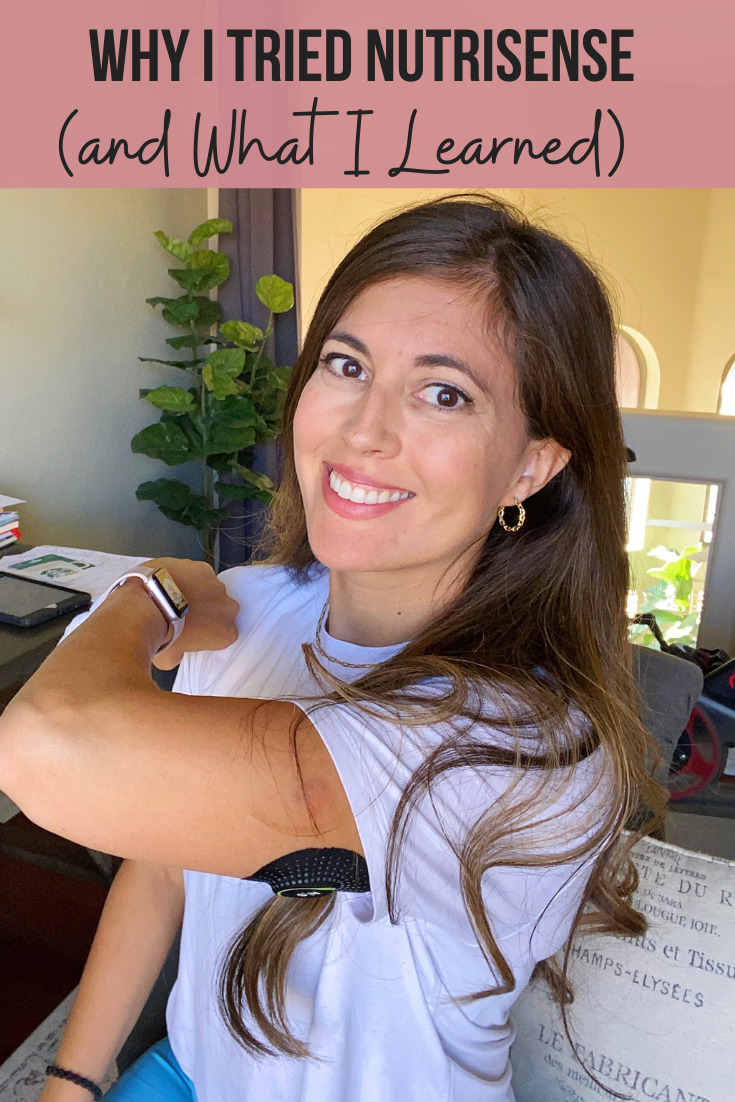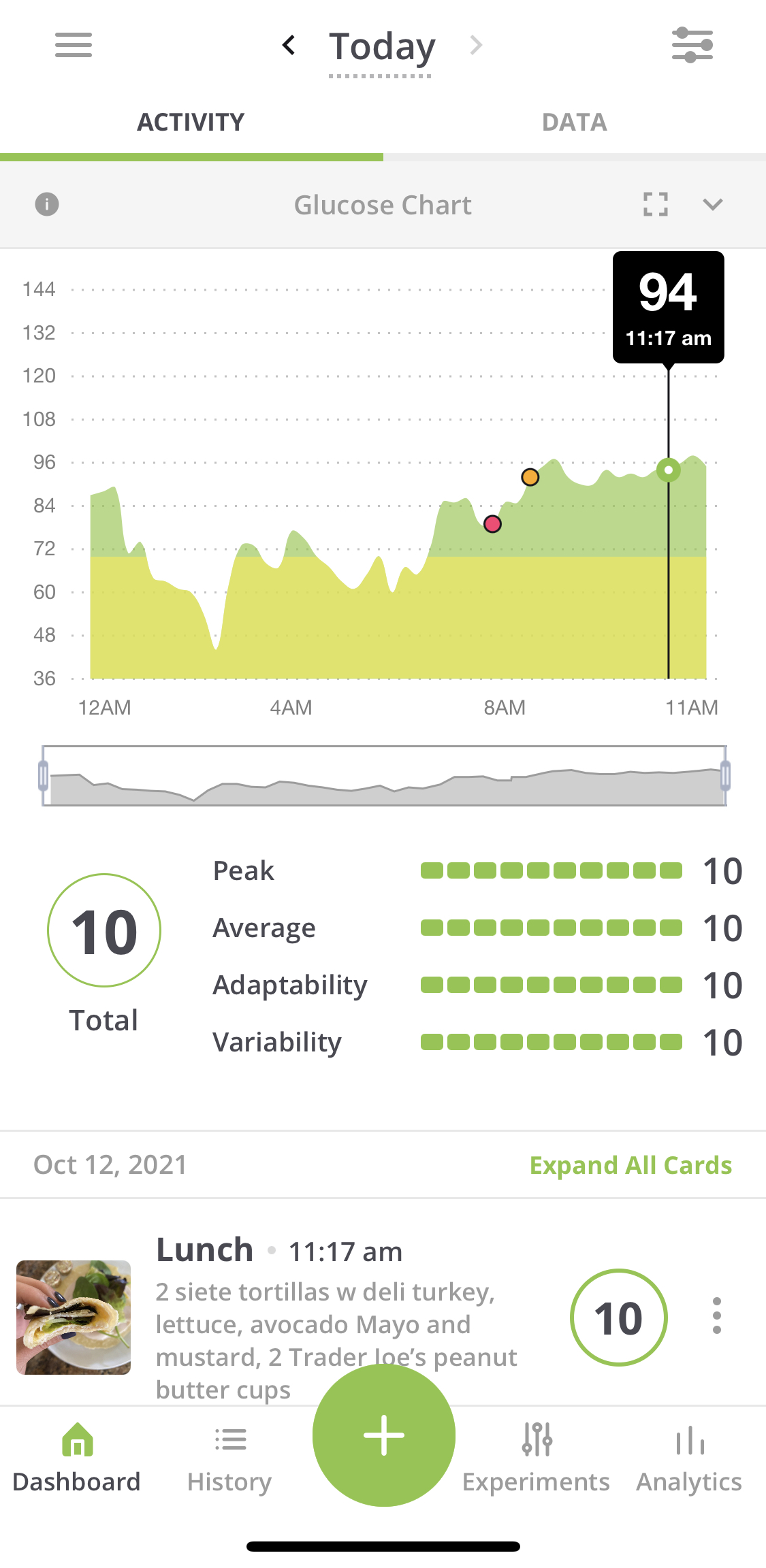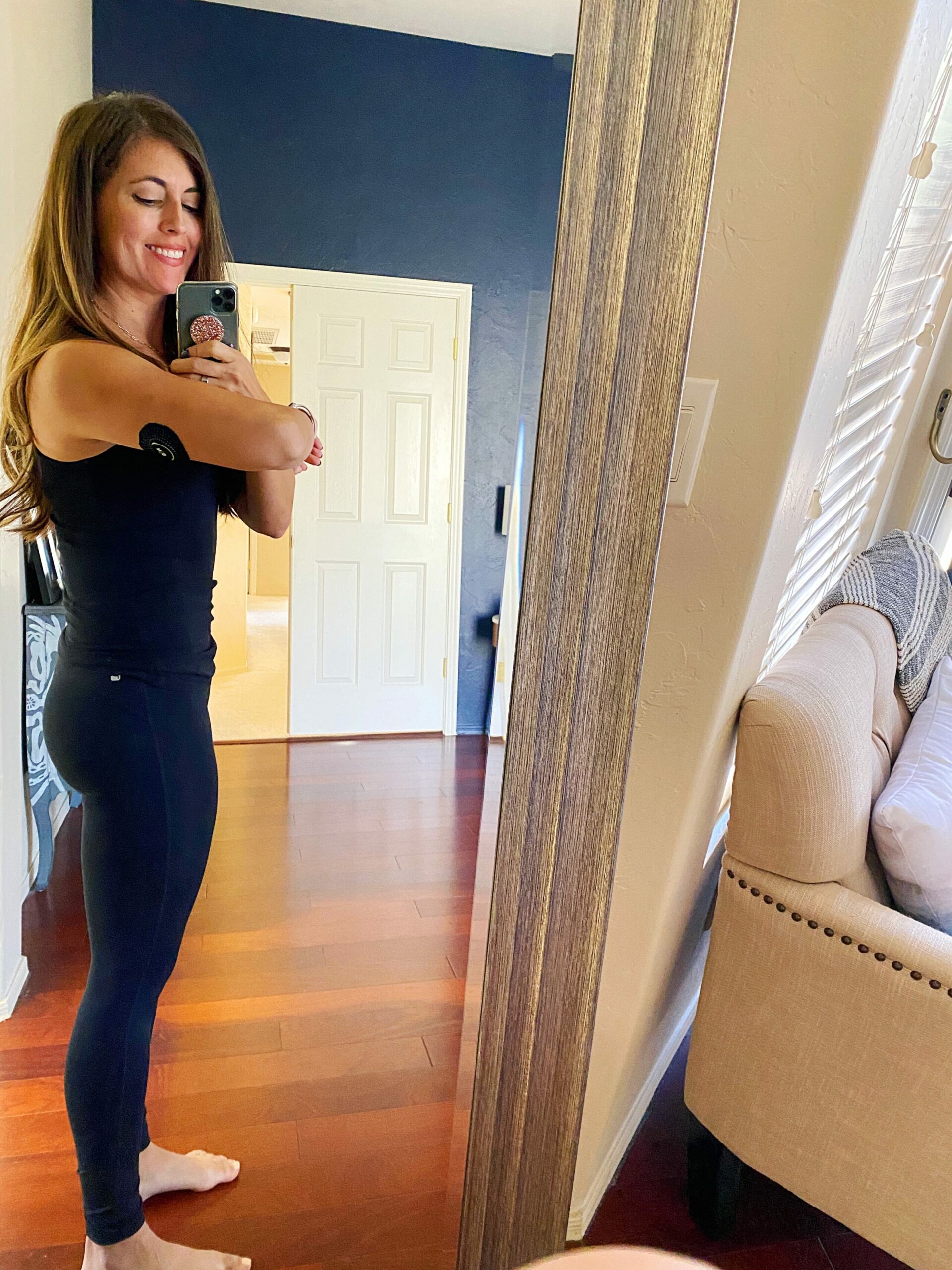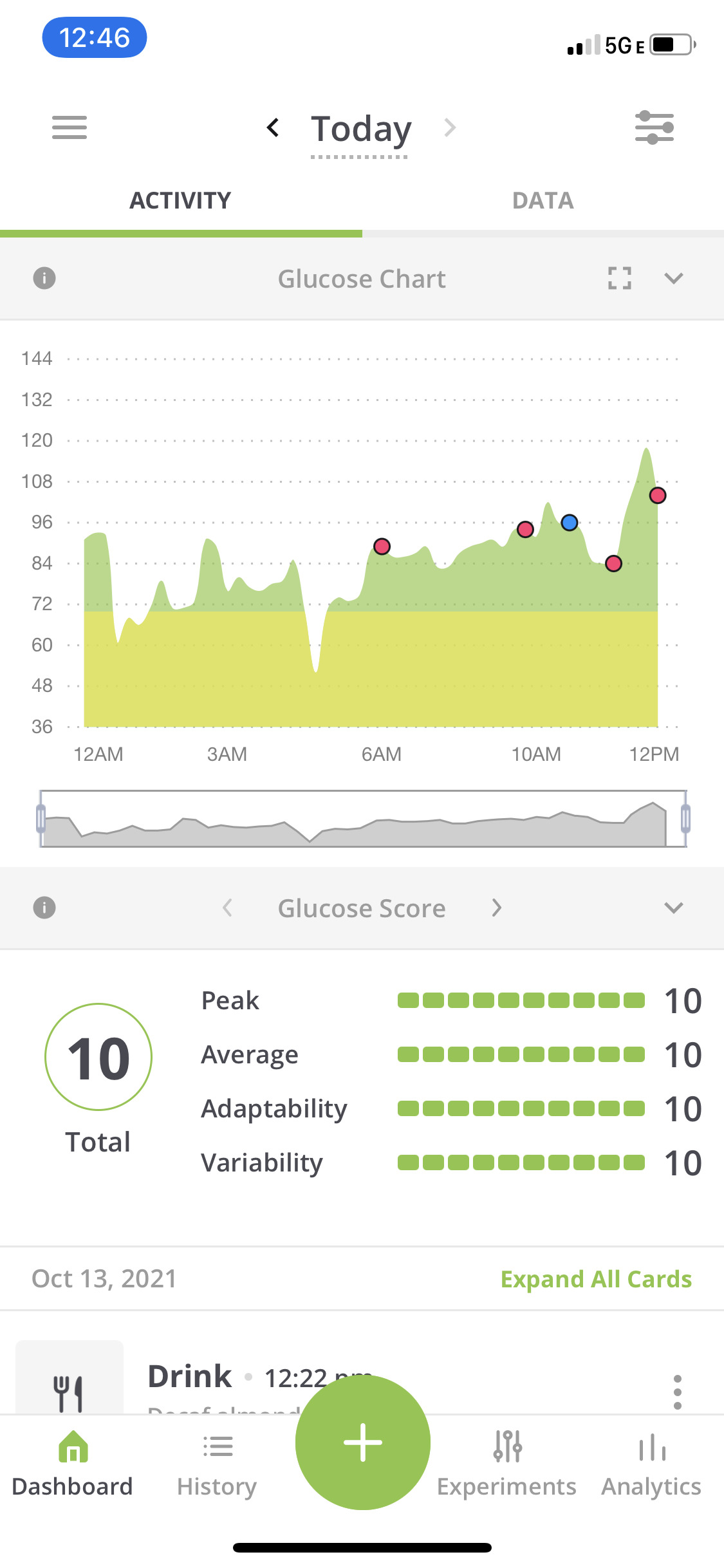[ad_1]
For the past week and a half, I have been trying Nutrisense and wearing CGM to monitor my glucose levels. I share a summary of my experience here! I was gifted with Nutrisense membership for 1 month to try, and this post is not sponsored. My code to try it out is GINA50 for $ 50 discount <- not a partner, I just wanted to share the discount with all of you.
Hello friends! How is the week? Thank you very much for all the beautiful wishes for P’s birthday! We had a great day celebrating and ended it with the requested Hibachi dinner. I hope you have a wonderful week too!
For today’s post, I wanted to share a summary of my experience with Nutrisense. I’ve been curious about this company for a while, especially after doing my blood test on Inside Tracker earlier this year. My fasting glucose levels were a little higher and I was worried it might be a deeper problem. I waited for it, and after my good friend Mia wrote about using Nutrisense to monitor her blood glucose levels, I knew I wanted to try. I contacted the company and was excited when they offered me a month to try it out and see how I liked it.
I received the product and I was SO nervous to put it on (hello, I’m a big fan of the needle) and I waited and waited until Mia said she would guide me through the whole process and attach hers at the same time. You can watch the video here and witness the moment I almost started having a panic attack live video. (She said, “Look, you can see the needle right there,” and I turned white.) I really wanted the data, so I took a deep breath and set to work. I’m really glad I did, because the ability to see my body’s reaction to different foods was extremely valuable.
(I smile, but I panic. It turned out that putting on CGM was NOTHING as I imagined it to be. It was painless and super easy.)

What is Nutrisense and how does it work?
Nutrisense is a program that offers expert guidance in accordance with the Continuous Glucose Monitor (CGM). CGM monitors your blood glucose at 15-minute intervals throughout the day so you can see how Sleep patterns, diet, exercise, stress and nutrition affect your blood sugar levels. Prolonged elevated glucose can cause inflammation and damage to the body, so it can be helpful to see how your body responds to the factors above, especially how it recovers. For example, if your blood glucose jumps after a food rich in carbohydrates or sweet, does it remain elevated? Or recovers in 2 hours? How tall is the spike ??
When you sign up for Nutrisense, your CGM comes with details of how to attach it. (You can watch me do this here!) You’ll attach the CGM and security patch, download the app, and scan the CGM to start tracking the data. It usually takes about an hour after the addition for your phone to recognize it and start scanning. (Just click “scan” in the app and hold your phone up on the CGM where the camera is located.)
Within the app, you are initially paired with a registered nutritionist who can help you interpret the data, make recommendations, and conduct experiments.
The service starts at $ 350 per month, and the price decreases depending on the weather. (With a 12-month commitment, that’s $ 199 / month.)
The CGM that Nutrisense uses is Freestyle Libre and expires after 14 days. (Your app will notify you when your sensor expires.)

What type of data do you receive and how do you interpret it?
Your blood glucose is measured 24/7 and you can see how much it rises and how long it takes to stabilize. It may be interesting to see jumps throughout the night on how different patterns affect your blood sugar.
I received this from my RD, who sent me frequent messages and was always available to answer questions: (this was after a disturbance, which caused a higher jump than I expected)
To help provide more context, I want to take you through what I’m looking at as I evaluate the glucose response, so let’s look at your 10/11 breakfast as an example (chocolate, smoothie, almond milk):
Peak (^ on your meal card). First, we want to look at the peak glucose value and try to avoid repeated exposure above 140. Your peak glucose value was 114, which is well below the threshold and a normal peak!
Exposure (hanging line on the meal card). Second, we also want a small area under the curve (AUC). So a rapid rise in glucose to 150, but a return to pre-meal glucose levels within 1 hour after a meal is a small area under the curve, but a slow rise in glucose to 130 and staying elevated for 4 hours would be very larger area under the curve. We want glucose to return to pre-meal values within 2-3 hours after a meal. You can help monitor your AUC by estimating the AUC values on your nutrition chart and by checking your standard deviation in the analysis. Your AUC was 42.9- I would say optimally that I am looking for <30, but <50 is still good!
Stability (triangle on the meal card). We also want to avoid large “shifts” in glucose. So it may be possible that you only reached 130 after a meal (which is good!), But your pre-meal value was 70, so that would be a big change. You can observe this by estimating your delta values, as we always want to aim for delta <30. Your delta was 33, which is great !!
Recovery (2 hours result on the meal card). Finally, we want glucose to return to pre-meal values within 2-3 hours after a meal. Your answer was 23, which tells me that you were 23 points from the base value of the 2-hour mark.

What I learned with Nutrisense CGM:
– Some buffers to prevent a spike in blood sugar, especially when eating a higher carb diet: take a walk before or after a meal, get some protein first, a moderate carb intake and a meal time. Because your insulin sensitivity is better during the day and decreases in the evening, you may tolerate food better if you eat it in the afternoon instead of late at night. For me, this is absolutely the case for wine – if I drink it late in the afternoon, it does not affect my sleep.
– Carbohydrates based on whole foods do not have a significant effect on me, especially when combined with proteins. (Fruits, apples, bananas, and oranges didn’t jump, even when I ate them myself.) Oatmeal, paleo pancakes, Siete tortillas, and starchy vegetables were the same. Refined carbohydrates, on the other hand, really caused a jump. We went to a party at a friend’s house and I had more pastries and refined carbs than usual (plus champagne) and my blood glucose was raised all night and the next day. It was interesting to see how one meal could affect your insulin sensitivity for the next day.
– Wine raises my blood sugar, tequila does not. (An important lesson haha.) Both recover well if I drink one glass, but two glasses led to elevated levels the next day. This experiment confirmed the fact that I was not doing well with a ton of alcohol and was a good reminder to keep it to a minimum. (I currently drink one or maybe two drinks a week.)
– Besides, my body loves tacos, beans and rice. 🙂 I had my usual Mexican dinner on Wednesday night with the family and without a huge jump.
– Calm down. A large percentage of our population is not metabolically flexible, which can affect how we deal with stress, injury and recovery from illness. I was worried that my last blood test showed higher fasting glucose, but this was able to confirm that it was not normal for me (my blood test was extraordinary) and a good indicator of my metabolic health. That was my main concern, and a sigh of relief was welcome.

Professionals:
– RD’s support was invaluable. I loved having the ability to ask questions, and she did a great job of teaching me how to see my patterns, evaluate my response, and ideal target ranges.
– The application is very well designed, easy to navigate and use. I liked using the app and found that even as a novice I understood it quite easily.
cons:
“I ate a little weird when I first put it on.” It was as if I was afraid to eat something that would increase it, and in the end I had to tell myself to overcome it and eat normally in a few days. The data would not help me if I ate only protein and vegetables for 14 days. So I had margaritas, tacos, desserts, all the things I usually eat, so it would provide a real picture. If you have a history of eating disorders, I would not recommend using this.
“It was awkward, and I finally took it off a few days earlier.” (I think it was more the glue than the actual sensor.) I recognize the privilege I have of being able to say, “I don’t want to wear this anymore,” and remove it when I have friends who depend on CGM to survive. I just wanted to put a little note here that I see you. <3 I didn't sleep well at all during the 11 days I had attached it - it was a super light sleep because I was subconsciously worried about rolling on it and sleeping on it at night. Also, I was a little shocked by the catheter when the pilot pulled it out for me - it's a small plastic tube, but it was longer than I expected, haha.
Overall, it was a really valuable experience and I enjoyed having access to all the data + learning from my Nutrisense RD.
Will I upload the second sensor? I think I will definitely do it eventually, but I’m taking a break for a few weeks. I want to conduct a few more experiments with the time of eating and eating certain foods alone + in relation to other foods.
Any questions about Nutrisense? Is this something you think you would do? If you decide to try it, you can use the code GINA50 for $ 50 discount 🙂
xo
Gina
[ad_2]
Source link